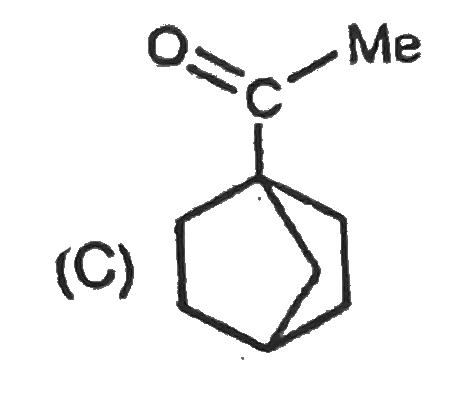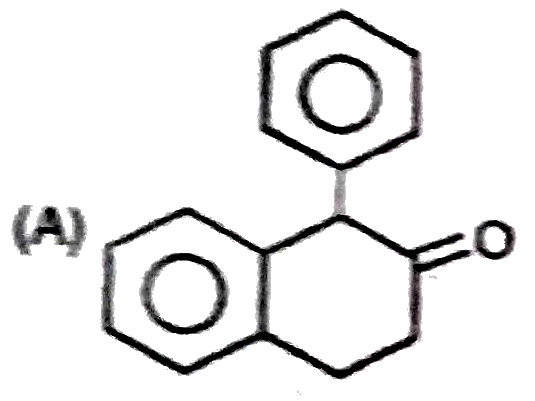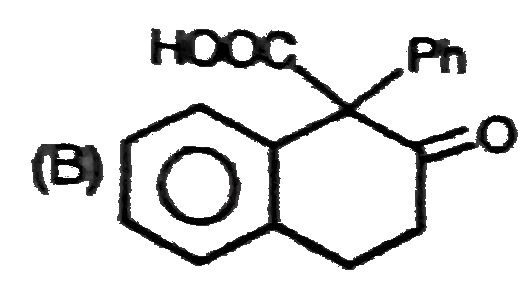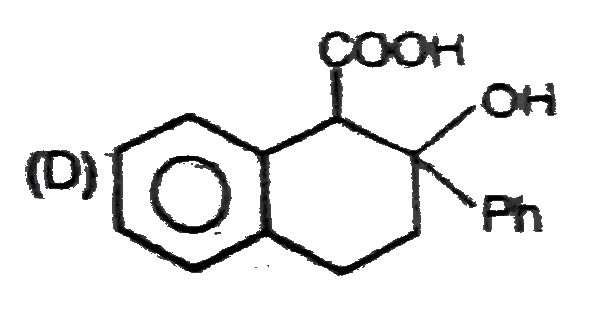Treatment of sodium salt of phenol with carbon dioxide under pressure brings about substitution of the carboxyl group, -COOH, for hydrogen of the ring. This provides a path of conversion of phenol into hydroxy carboxylic acids. The acids formed are industrially very important compounds and form many useful compounds.
Write the IUPAC name and the structure of the product formed from sodium phenoxide.
To solve the problem, we need to follow these steps:
Step 1: Understand the Reactants
We start with sodium phenoxide (C6H5O-Na+), which is the sodium salt of phenol. This compound will react with carbon dioxide (CO2) under pressure.
Step 2: Identify the Reaction Mechanism
The reaction involves the substitution of a hydrogen atom on the aromatic ring of phenol with a carboxyl group (-COOH) from carbon dioxide. The sodium phenoxide has a negative charge on the oxygen, which increases the electron density on the ortho and para positions of the benzene ring, making them more reactive towards electrophiles.
Step 3: Draw the Reaction
1. The sodium phenoxide (C6H5O-Na+) will react with CO2.
2. The negative charge on the oxygen atom will attack the carbon atom of CO2, leading to the formation of a carboxylate intermediate.
3. This intermediate will then undergo hydrolysis (addition of water) to form the final product.
Step 4: Write the Product Structure
After the hydrolysis, the product formed will be 2-hydroxybenzoic acid, which can be represented as follows:
- The structure consists of a benzene ring (C6H5) with:
- A hydroxyl group (-OH) at the 2-position (ortho position).
- A carboxylic acid group (-COOH) at the 1-position.
Step 5: Assign the IUPAC Name
The IUPAC name for the product is 2-hydroxybenzoic acid. This name indicates:
- The presence of a hydroxyl group (hydroxy) at the 2-position of the benzene ring.
- The presence of a carboxylic acid group (benzoic acid) at the 1-position.
Final Product Structure
The final structure can be drawn as follows:
OH∣C6H4−COOH
Where the -OH is at the 2-position relative to the -COOH group.
Summary
- The product formed from the reaction of sodium phenoxide with CO2 is 2-hydroxybenzoic acid.
- The structure includes a benzene ring with a hydroxyl group and a carboxylic acid group.
We start with sodium phenoxide (C6H5O-Na+), which is the sodium salt of phenol. This compound will react with carbon dioxide (CO2) under pressure.
The reaction involves the substitution of a hydrogen atom on the aromatic ring of phenol with a carboxyl group (-COOH) from carbon dioxide. The sodium phenoxide has a negative charge on the oxygen, which increases the electron density on the ortho and para positions of the benzene ring, making them more reactive towards electrophiles.
1. The sodium phenoxide (C6H5O-Na+) will react with CO2.
2. The negative charge on the oxygen atom will attack the carbon atom of CO2, leading to the formation of a carboxylate intermediate.
3. This intermediate will then undergo hydrolysis (addition of water) to form the final product.
After the hydrolysis, the product formed will be 2-hydroxybenzoic acid, which can be represented as follows:
- A hydroxyl group (-OH) at the 2-position (ortho position).
- A carboxylic acid group (-COOH) at the 1-position.
The IUPAC name for the product is 2-hydroxybenzoic acid. This name indicates:
- The presence of a hydroxyl group (hydroxy) at the 2-position of the benzene ring.
- The presence of a carboxylic acid group (benzoic acid) at the 1-position.
The final structure can be drawn as follows:
- The product formed from the reaction of sodium phenoxide with CO2 is 2-hydroxybenzoic acid.
- The structure includes a benzene ring with a hydroxyl group and a carboxylic acid group.
Topper's Solved these Questions
- BOOK - MODERN PUBLICATIONCHAPTER - ALCOHOLS, PHENOLS AND ETHERSEXERCISE - Revision Exercises II (Passage Based Questions)5videos
ALCOHOLS, PHENOLS AND ETHERS
- BOOK - MODERN PUBLICATIONCHAPTER - ALCOHOLS, PHENOLS AND ETHERSEXERCISE - Revision Exercises (Assertion Reason Questions)6videos
ALCOHOLS, PHENOLS AND ETHERS
- BOOK - MODERN PUBLICATIONCHAPTER - ALCOHOLS, PHENOLS AND ETHERSEXERCISE - Revision Exercises (Objective/Very Short Answer Questions) (Objective Questions) (Multiple Choice Questions)36videos
ALCOHOLS, PHENOLS AND ETHERS
- BOOK - MODERN PUBLICATIONCHAPTER - ALDEHYDES ,KETONES AND CARBOXYLIC ACIDSEXERCISE - UNIT PRACTICE TEST13videos
ALDEHYDES ,KETONES AND CARBOXYLIC ACIDS
Similar Questions
Treatment of sodium salt of phenol with carbon dioxide under pressure brings about substitution of the carboxyl group, -COOH, for hydrogen of the ring. This provides a path of conversion of phenol into hydroxy carboxylic acids. The acids formed are industrially very important compounds and form many useful compounds.
What is the name of the reaction?View SolutionTreatment of sodium salt of phenol with carbon dioxide under pressure brings about substitution of the carboxyl group, -COOH, for hydrogen of the ring. This provides a path of conversion of phenol into hydroxy carboxylic acids. The acids formed are industrially very important compounds and form many useful compounds.
formed from sodium phenoxide.View Solution
Knowledge Check
- Question 1 - Select One
Select the incorrect statement about Kolbe's reaction.
I. Phenoxide ion is less reactive than phenol toward electrophilic aromatic substitution.
II. A weak electrolyte CO2 is used in this reaction.
III. ortho-hydroxy benzoic acid is formed as the main product.
IV. Salicylic acid is formed as the main product.AOnly IBI and IIICII, III and IVDII and IV - Question 2 - Select One
In the presence of excess base and excess halogen a methylketone is converted first into a trihalo substituted ketone and then into a carboxylic acid.After the trihalo substituted ketone is formed hydroxide ion attacks the carboxyl carbon because the trihalo methyl ion is the group more easily expelled from the tetrahedral intermediate.The conversion of a methyl ketone to a carboxylic acid is called a haloform reaction because one of the product is haloform (CHCl3) or CHI3 or CHBr3.

Which of the following compound show haloform reaction and racemisation in OD−/D2OACH3CH2OHB C
C DCH3−C∣∣O−C∣EtH−Ph
DCH3−C∣∣O−C∣EtH−Ph - Question 3 - Select One
In the presence of excess base and excess halogen a methylketone is converted first into a trihalo substituted ketone and then into a carboxylic acid.After the trihalo substituted ketone is formed hydroxide ion attacks the carboxyl carbon because the trihalo methyl ion is the group more easily expelled from the tetrahedral intermediate.The conversion of a methyl ketone to a carboxylic acid is called a haloform reaction because one of the product is haloform (CHCl3) or CHI3 or CHBr3.

 A
A B
B C
C D
D
Treatment of sodium salt of phenol with carbon dioxide under pressure brings about substitution of the carboxyl group, -COOH, for hydrogen of the ring. This provides a path of conversion of phenol into hydroxy carboxylic acids. The acids formed are industrially very important compounds and form many useful compounds.
How will you convert the product into aspirin?View SolutionTreatment of sodium salt of phenol with carbon dioxide under pressure brings about substitution of the carboxyl group, -COOH, for hydrogen of the ring. This provides a path of conversion of phenol into hydroxy carboxylic acids. The acids formed are industrially very important compounds and form many useful compounds.
Why do we use sodium phenoxide rather than phenol for this reaction?View SolutionPhenols on treatment with chloroform in the presence of aqueous sodium hydroxide or potassium hydroxide solution give hydroxy aldehydes. In this reaction, the formyl group is directed to ortho position. But if one of the ortho position is occupied then para product is formed. The reaction is electrophilic substitution reaction.
What is the name and the structure of the final product formed.View SolutionIn presence of excess base and exces shalogen a methyl ketone is converted first into a trihalo substituted ketone and then into a carbonylc acid . After the trihalo substituted ketone is formed hydroxide ion attacks the carboxyl carbon because the trihalo methyl ion is the group more easily expelled from the tetrahedral intermediate .The conversion of methyl ketone to a carboxylic acid is called a haloform reaction because one of the product is halofor (CHCl3) or CHI3 or CHBr3.


Product " " is :View SolutionIn presence of excess base and exces shalogen a methyl ketone is converted first into a trihalo substituted ketone and then into a carbonylc acid . After the trihalo substituted ketone is formed hydroxide ion attacks the carboxyl carbon because the trihalo methyl ion is the group more easily expelled from the tetrahedral intermediate .The conversion of methyl ketone to a carboxylic acid is called a haloform reaction because one of the product is halofor (CHCl3) or CHI3 or CHBr3.

 View Solution
View Solution

